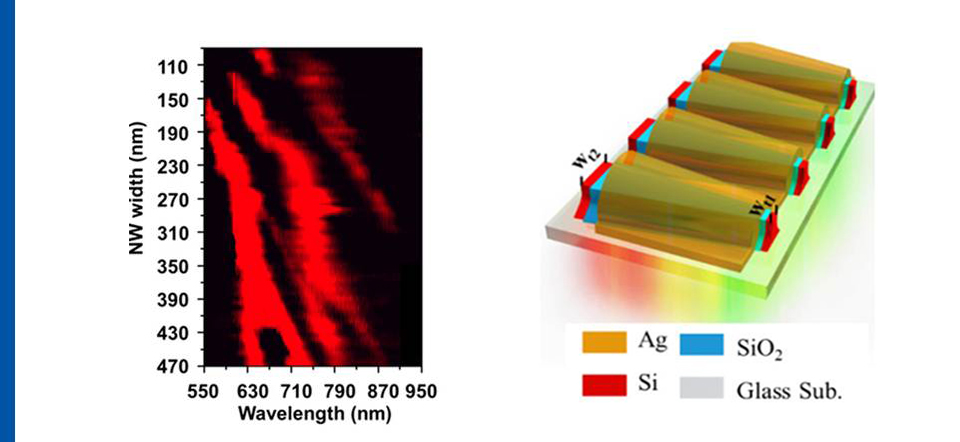SIMIT, Chinese Academy of Sciences Made Important Progress in the Research on the Broad-spectrum Photoluminescence from Silicon Nanowire Arrays
Date:31-08-2017 | 【Print】 【close】
Recently, the SOI materials and devices research group of the State Key Laboratory of Functional Materials for Informatics, Shanghai Institute of Microsystem and Information Technology (SIMIT), Chinese Academy of Sciences, made important progress in the research on the broad-spectrum photoluminescence from silicon nanowire arrays. The research team studied the luminescence properties of the silicon nanowire arrays by combining SOI with surface plasmons technology, and cooperated with Fudan University to calculate the corresponding relationship of the photoluminescence peak position of silicon nanowire and nanocavity resonant mode based on the finite difference time domain (FDTD) theory, which laid an experimental and theoretical foundation for the silicon based optoelectronic integration, and was conducive to promoting the large-scale application of silicon-based light source. The related research findings were published in Nano Lett., 2017, 17 (3), pp1552-1558, entitled "Multiband Hot Photoluminescence from Nanocavity-Embedded Silicon Nanowire Arrays with Tunable Wavelength". Article link: http://pubs.acs.org/doi/abs/10.1021/acs.nanolett.6b04675.
As the most important cornerstone of the microelectronics industry, Si has played a crucial role in the development of integrated circuits. But with the device size getting smaller and smaller, the excessive interconnection and integration brought about the signal delay and device overheating problem, posing great challenges to the continual development of the microelectronics industry with large scale integrated circuits as the representative. And silicon-based optoelectronic integration is the ideal way to solve this problem. However, to integrate two completely different technologies (Electronics and photonics) on the same wafer, the biggest challenge is the light source problem. For light-emitting devices, a large number of current research focused on GaAs, InGaAs and other direct bandgap semiconductors. However, there are still huge obstacles to implement the integration of direct bandgap semiconductor materials such as III-V family and silicon base. However, silicon has extremely low luminous efficiency due to its indirect bandgap structure, and cannot achieve the effective emission of light. Mu Zhiqiang, Di Zengfeng, Wang Xi and other researchers of the SOI research group combined the SOI technology and surface plasmon polaritons technology and realized luminescence enhancement of nanocavity resonance enhanced silicon nanowire arrays with trapezoid-like structure by processing silicon nanowire into trapezoid-like structure. Contrast experiment and FDTD calculation results showed the one-to-one correspondence between the luminous peak position of the nanowire array and the nanocavity resonant mode. And the continuous tenability of the luminous peak position of silicon nanowire arrays in the visible and near-infrared regions was achieved by preparing the silicon nanowire arrays with size gradient. This has opened up a new way for the silicon-based light source, and will be a strong impetus to the development of silicon-based optoelectronic integration.
This work is supported by the innovative research group of National Natural Science Foundation of China, Outstanding Youth Fund, high mobility material innovation research team of the Chinese Academy of Sciences and other related research programs.

Fig. a and b: Diagram of size gradient type nanocavity enhanced silicon nanowire array with trapezoid-like structure and SEM photographs; c: Luminescence spectrum and nanocavity resonance mode distribution.